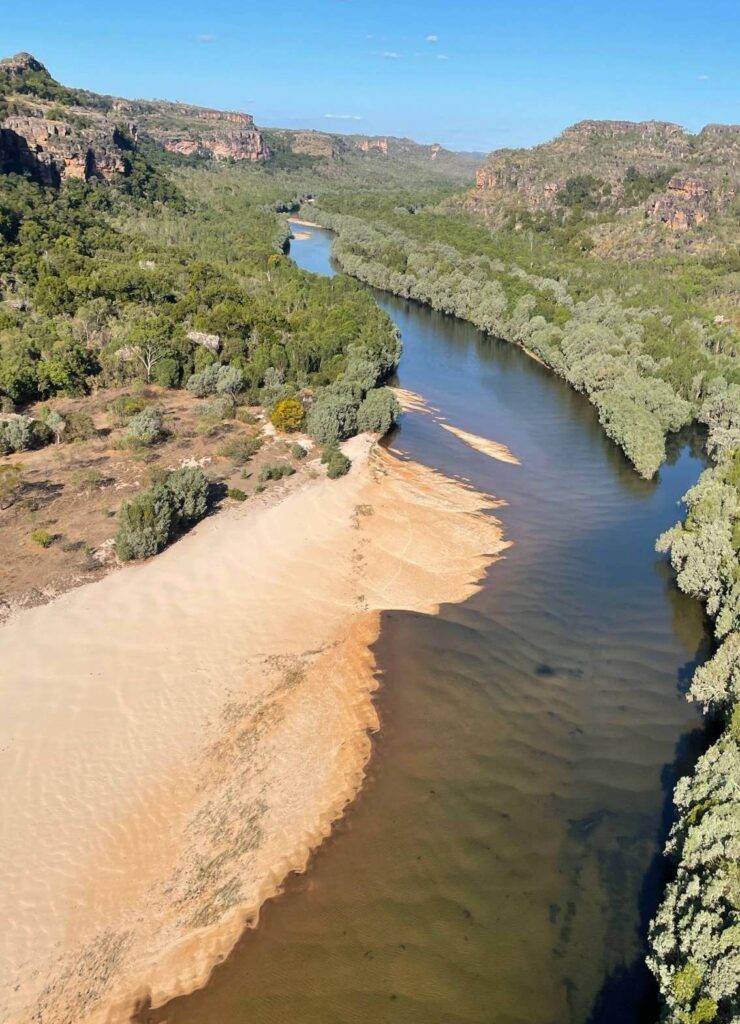The doors are off, and the wind is whistling through the cabin of this four-seater Robinson 44 helicopter.
The skies are clear, and the temperature is nudging 27 degrees on this pleasant August day.
Flying at 500 feet, the conditions are perfect to view the breathtaking scene below, and Mark, our pilot, expertly tilts the craft to provide us with the best outlook of this World Heritage site.
We are in Kakadu National Park, Northern Territory, Australia, 254km east of Darwin.
The park covers some 20,000 square kilometres and includes traditional the lands of many Aboriginal clans. Since the late 1970s, Kakadu’s traditional owners have leased their land to the director of National Parks to be jointly managed as a national park.
The excitement grows, and after the mandatory preflight photos, we lift off from Jabiru Airport – Jenny, me, and our good friend Christine.
This 45-minute scenic flight with Kakadu Air will take us to places inaccessible by vehicles, and we reckon a chopper is the best way to explore this vast landscape. A fixed-wing scenic flight is an alternative, but our advice is to pay extra for the helicopter experience.

Get a grip
A tip – you will need to grip your camera phone tightly when taking photos because of the fierce wind force that is likely to whip it out of your hand if you lean too far out to get that specky shot.
We head towards the Arnhem Land plateau, locally known as the Stone Country, a vast wilderness area of 97,000 sq km in the northeast region of the Northern Territory.
Its spectacular landscape is rich in Aboriginal culture and defined by rocky escarpments, wetlands, rivers, gorges, and waterfalls. The Yolngu traditional landowners require permits for visitors to enter this area.
The first landmark we see is the unsightly open cut Ranger Uranium Mine, a scar on the landscape, and an environmental disaster. However, it should be rehabilitated by 2026, and returned to the Mirarr traditional owners.
A short time later we are over the spectacular rocky escarpments to view one of the highlights of the tour, The Archway. Mark does a couple of laps to allow us multiple views of this fabulous natural rock formation, then turns towards the East Alligator River Gorge and follows it upstream to Mikinj Valley and further to the Magela Wetlands. We fly low enough to see a variety of wildlife including horses, birdlife, and an abundance of saltwater crocodiles.

Wet or dry
It’s said that all good things come to an end, and so it is that our 45-minute scenic flight is over as we land back at Jabiru airport in awe of what we have visually experienced.
The cost for this dry season flight (May-October) is $495 each, whereas the cost for the 60-minute wet season helicopter flight (November-April), where you will see the majestic Jim Jim and Twin waterfalls, is $660 each. This compares with the fixed wing flight of $250 each. Our chopper flight was much more expensive, but believe us, it was well worth the extra bucks.
This was the experience of a lifetime. We would strongly recommend adding both the dry and wet season chopper tours to your bucket list.
Our friend Christine did the ‘wet’ tour later in the year and described it as breathtaking. For Jenny and me, we added a tick for the ‘dry’ tour, and our list gets smaller.
Have you been to Kakadu? What was your favourite part? Why not share your experience in the comments section below?
Also read: Hard or soft? What’s the best luggage for your next trip?

